The chic shrubs of garden azalea blooming in spring are increasingly found in areas of summer residents. Tree shrubs from the heather family are an exquisite decoration of the territory near a private house. However, many flower lovers do not have experience in growing exotics, having no idea how to properly cover the rhododendron for the winter.
Content
Need for shelter
Heather-flowered eukaryotes are fastidious plants, therefore, in addition to creating optimal growing conditions, the culture needs proper shelter for the winter. Otherwise, the root system of the rhododendron, which is close to the soil surface, will partially or completely freeze. Fragmented frozen roots will subsequently cause the development of diseases and the fall of the buds that have begun.
The genus of heather combines more than five hundred subspecies of evergreen, deciduous and semi-deciduous tree-like shrubs. Many types are frost-resistant and in vivo grow in the northern regions and do not need shelter. However, most modern varieties and hybrids do not withstand frosts of -20 degrees and die. Therefore, many flower lovers are concerned about the question of whether to cover rhododendrons for the winter.
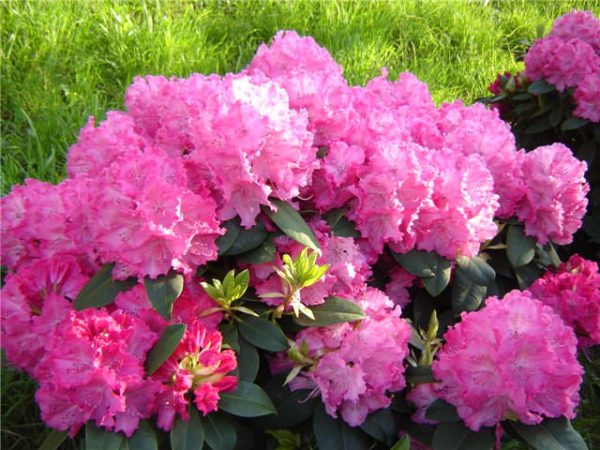
Shelter Dates
Those who have no experience in growing this culture of summer residents are interested in the fact at which subzero temperature the plants should be covered. Almost all varieties and hybrids tolerate frosts from -8 to -12 degrees. However, with a stable temperature of -12-15 degrees, you should immediately take care of a reliable cover for the root system of pets. This is especially true for young seedlings who are under the age of three.
If the temperature indicators are not stable and differ, then an increase, then a decrease in the mercury column, with shelter of the plants is worth the time. Premature cover of flower buds planted since autumn in this case may lead to their debate. Also, as a result of a long stay under the covering material at a temperature above minus 5 degrees, the root neck of the plant will be affected by mold.
The established dates for sheltering rhododendrons, depending on the region, begin from the end of October and end until mid-December.
In outskirts of Moscow
Shelter rhododendrons for the winter in the suburbs flower growers are engaged at a stable temperature from -8 to -12 degrees. To get a good lush flowering shrub in May, you need to cover the culture, starting in mid-November. The most reliable refuge for young seedlings is air-dry, using heat-holding and waterproof materials. Such shelters will exclude both freezing out, and exudation of the root system and flower buds.
In the middle lane
Experienced flower growers note that the period of shelter of rhododendrons directly depends on the condition and age of the shrub. As a rule, in the middle lane, the procedure is carried out from late October to early December. It is not worth rushing to shelter a decorative culture in the regions of the Middle Strip, because the first autumn frosts are useful for garden azaleas. They stimulate the passage of chemical and biological processes that increase the immunity of plants.The main thing is to insulate the bushes before the air temperature drops below -15 degrees.
In the Urals
Light autumn frosts of the Ural region are easily tolerated by garden azalea, making the plant more resilient. However, starting in late October, rhododendrons should be sheltered for the winter. The procedure must be carried out when the night air temperature drops to the level of 12 degrees.
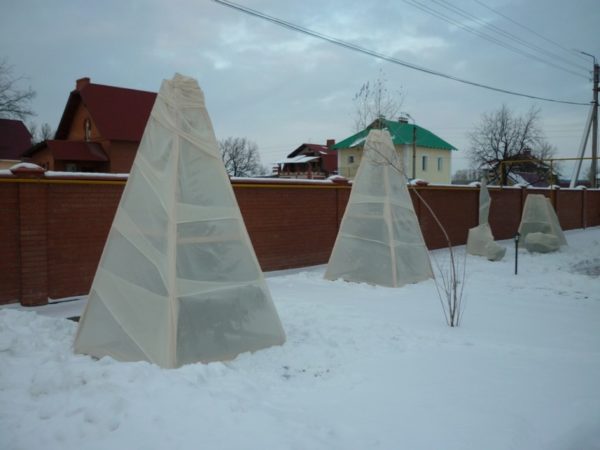
In Siberia
It is worth preparing rhododendrons in this region since the beginning of frosts. In order for the young bushes not to freeze, cover the plants from the last week of September, ending in early November. By warming the bushes, make sure that the protective material will not only protect against frost damage, but also will not let the flower buds and the root neck shout.
In the Leningrad region
With special zeal, take care of young bushes of hybrid forms of rhododendron, unstable to severe frosts. The St. Petersburg region is characterized by early and sharp cooling, so even the most frost-resistant first-year seedlings can suffer from low temperatures with untimely shelter.
The surface root system of the plant is most vulnerable, therefore, it will need a warm and serious shelter. When soil freezes to -5 degrees, the root neck of a young rhododendron is on the verge of freezing, which means that the entire plant is at risk. It is necessary to carry out warming of bushes in the Leningrad region from mid-September.
Plant preparation
The timing of shrubbery depends on the characteristics of the variety or hybrid. Before sheltering rhododendrons for the winter, it is worthwhile to conduct several preparatory tricks that will help dicotyledonous eukaryotes survive the cold.
Top dressing
The plant needs to replenish the supply of minerals even at the end of the season. The process of ontogenesis of the embryonic shoot of rhododendron begins to occur from mid-August to the end of September. In order for the shrub to enjoy lush flowering in the spring after wintering, elements important for growth and photosynthesis must be present in the root zone of the plant before the temperature drops drastically. Only when all the substances necessary for growth are absorbed in the fall, the plant enters the dormant phase, reducing the rate of metabolic processes.
In order for all the processes necessary for entering the dormant phase to be completed on time, the autumn fertilizing should not contain nitrogenous compounds that stimulate plant growth. In late autumn, when frost occurs, granular fertilizers can be poured into the root zone of the bush:
- superphosphate - 25 g;
- potassium sulfate - 25 g;
- urea - 15 g.
During the winter, granular substances will gradually dissolve, and with the onset of spring heat, they will be absorbed by the root system of the plant.
Pruning
The plant does not particularly need a formative shortening of the branches, since at the genetic level it has an outgrowth of the symmetrical shape of the bush. Therefore, before the winter begins, garden azalea should only be cut out sick and damaged branches. The only reason for shortening the bush is its rejuvenation.The procedure is performed with the loss of decorativeness and lush flowering of rhododendron.
In the fall, before the onset of frost, crop shoots are cut 5 cm above the level of sleeping buds. After pruning, after 10-12 days, the sleeping rudiments will start to grow, and in the next season, the decoration of garden azaleas will be restored. To cut off sections of the cut to prevent infection, immediately sprinkle with wood ash or grease with brilliant green.
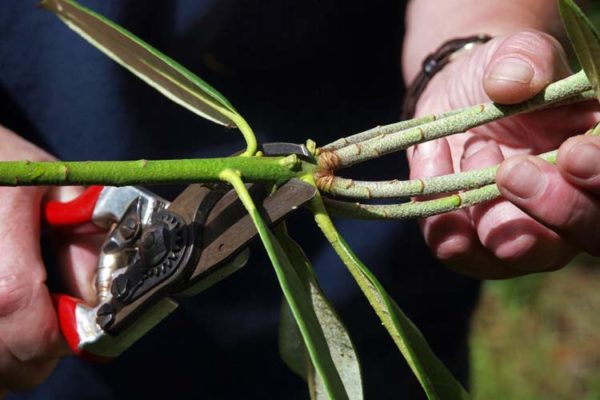
Disease and Pest Treatment
Rhododendrons, like all plants, have their own diseases and insect pests that can cause irreparable harm to the plant. Instability to pathogens and insect parasites depends on the species and plant variety. So, for example, evergreen varieties that grow in the sun are more susceptible to infections and pest attacks than those planted under the canopy of trees. Depleted plants are most susceptible to diseases, therefore, throughout the season, rhododendrons need to create optimal conditions for development.
Before wintering begins in late September and early October, it is worth spraying plants with growth stimulants that will increase their immunity: Epin, Heteroauxin, Zircon. Before warming with covering material to prevent damage by rot, treat the shrubs with the preparations: Fitosporin, Maxim, Fundazin, Effect, Previkur. To destroy the larvae of pests wintering on foliage and in the soil under the plant, before insulating, spray with insecticides: Aktara, Confidor Maxi, Oppercot, Actellik.
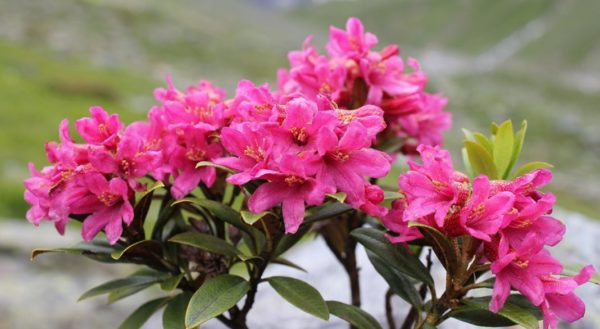
Covering materials
Each grower should select the most effective material for warming shrubs individually, starting from the climatic conditions of the region and opportunities.
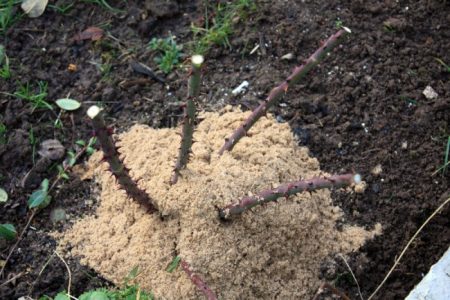 You may be interested in:
You may be interested in:Lapnik
Branches of evergreen trees and shrubs are the most affordable material for sheltering garden azaleas. The built insulation hut does not get wet, creates an air gap, retains snow well and protects from severe frosts. In addition, the specific smell of spruce frightens off rodents, so this material is especially valuable when sheltering young bushes. To cover rhododendrons with natural material for the winter growing in sunny areas is to protect shrubs in the spring from ultraviolet burns.
Dry corn stalks
Another natural material that can be used to protect perennials from frost. However, during heavy rains, corn stalks should be covered with polyethylene.
Sawdust
Wood shavings well protect the surface root system of the plant from frost. However, it is not recommended to cover the bush completely. It is best to pour it near the rhododendron with a layer of 20-30 cm. In case of heavy rains, cover the sawdust with polyethylene, and before falling asleep in the root zone of the culture, stir with a small amount of citric acid.
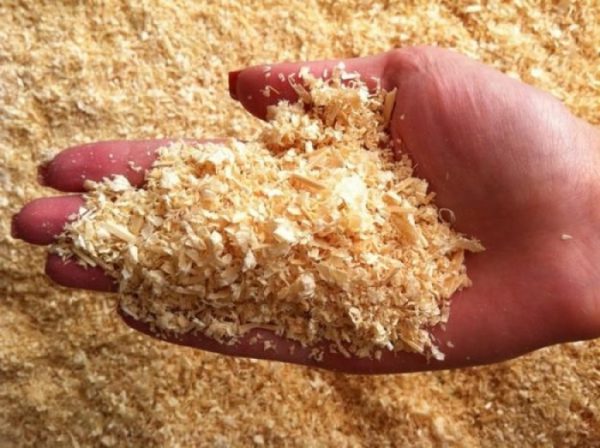
Thermal insulation flooring
Due to the unique properties of thermosetted geosynthetics, rhododendrons can be protected in the northern regions. Thermal insulation materials are moisture-permeable, so it is recommended to stretch them under polyethylene. Such a “greenhouse in a greenhouse” is suitable for sheltering ornamental shrubs in the Leningrad region and Siberia.
Protective constructions
Designs designed to protect plants from cold, protect shrubs from harmful UV radiation and rodents, and allow air to pass through well.Mini greenhouses include dense agrofibre and metal arches insulated with PVC braid. Designs are made of alloys that are not susceptible to corrosion and the effects of subzero temperatures. In such a cover, rhododendrons do not freeze, receiving the oxygen necessary for a comfortable wintering.
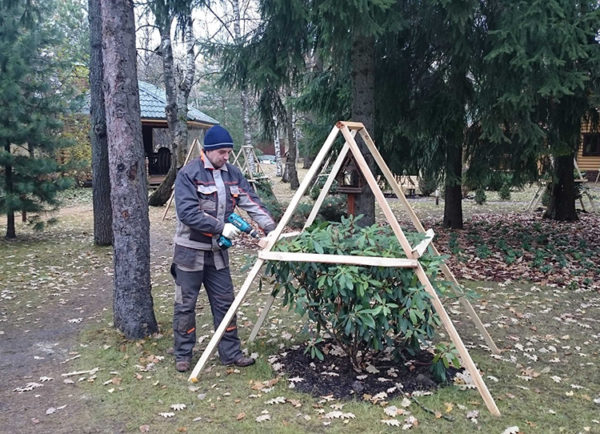
Proper cover
Necessary rhododendron care in autumn and preparation of a decorative plant for winter depends on the individual characteristics of the culture. Evergreen and deciduous heather-flowering eukaryotes differ from each other in resistance to frost. However, both of these subspecies require sheltering of the root system.
Evergreen
Evergreen garden azaleas do not drop foliage for the winter, which, when frost sets in, folds and unfolds when spring heat sets in. The shelter of these species differs from the variety and the hybrid. In good insulation with spruce branches or lutrasil varieties need:
- Percy Weisman;
- Gold Trach;
- Goldflimmer
- Grandiflorum;
- Nova Zembla;
- Naselle;
- Exbury "Fireball";
- Golden Sunset;
- Simona
In a light shelter with spruce branches, needles or wood shavings, the varieties need:
- Berry Rose
- Alfred;
- Bieber
- Blue Peter;
- Blue Tit;
- Bourzault;
- Gold Dust;
- Violetta;
- Gassin;
- Irena Koster;
- Dagmar.
Deciduous
Deciduous decorative shrubs of the heather family are easier to care for than evergreens. Popular varieties and hybrids of Canadian, yellow, Daurian and Japanese rhododendron can simply be insulated in the root zone with a layer of 15–20 cm with pine needles, foliage, and wood shavings. However, if the sapling of deciduous garden azalea is less than two to three years old, it must be covered with spruce branches or heat-insulating material.
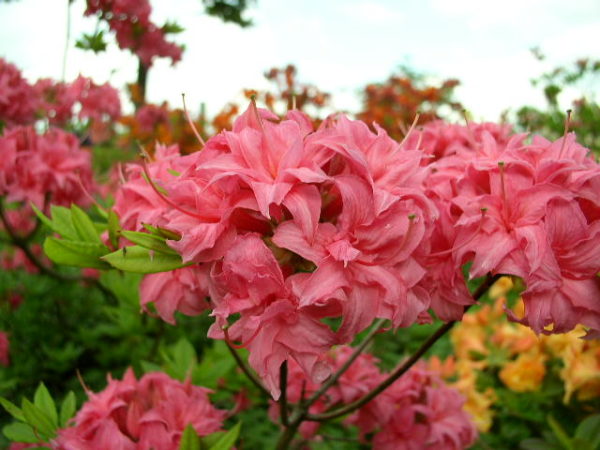
Advice
In order to avoid mistakes in preparing rhododendrons for winter, one should adhere to the recommendations of experienced gardeners:
- it is generally impossible to water rhododendrons during wintering, gradually reducing the flow of fluid from the beginning of autumn;
- insulation material should not be removed from the bushes as soon as the snow melts. The procedure is carried out after warming up the soil and the absence of the threat of spring temperature drops to a minus mark;
- warming shrubs, take care of flower buds and preserving apical shoots. The procedure is performed by bending the branches to the ground. Despite its massiveness, even adult bushes tolerate such an inclination well;
- check the shelters throughout the winter: brush off excess snow, replace the agrofibre spoiled by the wind in time;
- if the plant is covered too early, the transition zone from the root to the stem will begin to churn, the leaves will become covered with mold spores, and the bush will die. To prevent rotting, open the covered garden azalea from the sunny side. Having kept the bush wide open for two weeks, when establishing a stable minus temperature, cover again.
With the right warming "pets", they will winter without any problems. And in the spring, the owners will be pleased with lush, vibrant colors.

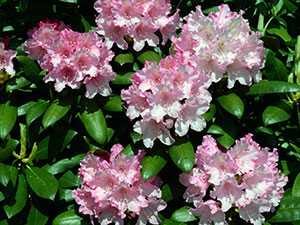 Rhododendrons in the suburbs - how to care and plant?
Rhododendrons in the suburbs - how to care and plant?